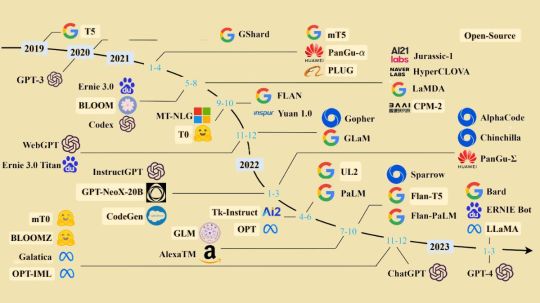#buildingblock
Explore tagged Tumblr posts
Text

😜😜😜
FUNWHOLE Light Festival continues! And on this post: the F9013 A-Frame Cabin.
Set available here: https://www.funwhole.com/?ref=hdgtpjvc https://www.amazon.com/stores/FUNWHOLE/FUNWHOLE/page/1EB068D0-065E-4A51-AF1A-1F95C506C42E
#funwhole#buildingbrick#buildingblock#toys#lego#moc#bricks#toyblocks#lighting#afol#afob#lightfestival#minimstories
3 notes
·
View notes
Text






2 notes
·
View notes
Text
Mastering Language Models: AI Conversation Building Block

What are language Models?
One kind of machine learning model that has been taught to perform a probability distribution over words is called a language models. In short, a model uses the context of the provided text to forecast the next best word to fill in a blank space in a sentence or phrase.
Since language models enable computers to comprehend, produce, and analyze human language, they are an essential part of natural language processing (NLP). A large text dataset, such a library of books or articles, is mostly used to train them. The next word in a phrase or the creation of fresh, grammatically and semantically coherent material are then predicted by models using the patterns they have learned from this training data.
The Capabilities of language models
Have you ever noticed how the Microsoft SwiftKey and Google Gboard keyboards have clever capabilities that automatically suggest whole phrases while you’re composing text messages? Among the many applications of language models is this one.
Many NLP activities, including text summarization, machine translation, and voice recognition, require it.
Creation of content: Content creation is one of the domains where language models excel. This involves using the information and terms supplied by people to generate whole texts or portions of them. Press releases, blog entries, product descriptions for online stores, poetry, and guitar tabs are just a few examples of the kind of content that may be found there.
POS (part-of-speech) labeling: World-class POS tagging performance is achieved by extensive use of this model. POS tagging assigns a noun, verb, adjective, or other part of speech to each document word. The models can estimate a word’s POS based on its context and the words that surround it in a phrase since they have been trained on vast volumes of annotated text data.
Addressing questions: It is possible to train language models to comprehend and respond to queries both with and without the provided context. They may respond in a variety of ways, such by selecting from a list of possibilities, paraphrasing the response, or extracting certain words.
Summary of a text: Documents, articles, podcasts, movies, and more may all be automatically condensed into their most essential chunks using language models. Models may be used to either summarize the material without using the original language or to extract the most significant information from the original text.
Examination of sentiment: Because it can capture the tone of voice and semantic orientation of texts, the language modeling technique is a strong choice for sentiment analysis applications.
AI that can converse: Voice-enabled apps that need to translate voice to text and voice versa inevitably include language models. This may respond to inputs with relevant text as part of conversational AI systems.
Translation by machine: Machine translation has been improved by ML-powered language models’ capacity to generalize well to lengthy contexts. It may learn the representations of input and output sequences and provide reliable results rather than translating text word for word.
Finishing the code: The capacity of recent large-scale language models to produce, modify, and explain code has been outstanding. They can only, however, translate instructions into code and verify it for mistakes to finish basic programming jobs.
Key aspects of language models
1. Natural Language Processing (NLP)
Language models use NLP approaches to analyze human language and extract meaningful components from words, phrases, and paragraphs.
2. Training
The models are trained on large datasets of text sources such as books, webpages, papers, and more. Training helps them anticipate the next word in a phrase and write like humans by teaching grammar, context, and word connections.
3. Deep Learning
Most recent language models, such as GPT and BERT, rely on deep learning, particularly transformer topologies, to effectively interpret language patterns. Transformers are effective at addressing long-term text dependencies.
4. Applications
It may be used for different activities, such as:
Text creation: Writing tales, poetry, and essays.
Translation: Language translation.
Natural discussion with chatbots.
Summarization: Shortening lengthy articles.
Answering questions with knowledge.
5. Examples
Famous language models include:
GPT-3 by OpenAI generates human-like writing and powers AI apps.
BERT by Google: Useful for search and sentiment analysis, optimized for linguistic context.
The Text-to-Text Transfer Transformer (T5) treats all NLP issues as text production problems and is used for many purposes.
It can allow robots to read, write, and speak like humans.
The Future of language models
Historically, AI business applications concentrated on predictive activities including forecasting, fraud detection, click-through rates, conversions, and low-skill job automation. These restricted uses took great effort to execute and interpret, and were only practical at large scale. However, massive language models altered this.
Large language models like GPT-3 and generative models like Midjouney and DALL-E are transforming the sector, and AI will likely touch practically every part of business in the next years.
Top language model trends are listed below.
Scale and intricacy: The quantity of data and parameters learned on language models will certainly scale.
Multimodality: Integration of language models with visuals, video, and music is intended to enhance their worldview and allow new applications.
Explaining and showing: With more AI in decision-making, ML models must be explainable and transparent. Researchers are trying to make language models more understandable and explain their predictions.
Conversation: It will be utilized increasingly in chatbots, virtual assistants, and customer service to interpret and react to user inputs more naturally.
Language models are projected to improve and be utilized in more applications across fields.
Read more on govindhtech.com
#MasteringLanguageModels#AIConversation#BuildingBlock#machinelearning#voicetext#DALE#naturallanguageprocessing#NLP#OpenAI#ai#Keyaspectslanguagemodels#deeplearning#languagemodels#Applications#technology#technews#news#govindhtech
0 notes
Text




MOQ 3 sets, Big Blue EVA Building Blocks now could custom colors .
www.diliindustrial.com Email: [email protected] Tel/WhatsApp/We chat: 86 182 3922 6198
0 notes
Text

"Factory 01" (Post-industrial)
[Ascension series]
by michael mathews
mixed media & collage on canvas
18x24x1.5 inches
2025
www.michaelmathewsart.com
#contemporaryart#abstractart#art#abstraction#fineart#collage art#factories#industrialism#geometricart#capitalism#mixedmediaart#buildingblocks#michaelmathewsart#singulart
9 notes
·
View notes
Text
instagram
Using my adult money on toys, no regrets! 😂💸
I honestly bought this little alien because:
1️⃣ I want to use it for stop motion practice 🎥👽
2️⃣ It’s affordable and cute! For the price, the quality is decent—definitely a "you get what you pay for" situation. The bricks are tiny, some have scratches, and they’re a bit tricky to snap together, but hey, no missing pieces!
3️⃣ A test run to see if I actually enjoy building blocks before diving into the premium world of LEGO 🤣
Would you buy one too? Or are you already deep into the LEGO life?
#NanoBlocks#BrickBuilds#MiniBlocks#ToyPhotography#BudgetToys#BricksMakeAWiseLife#CuteAlien#BuildingBlocks#StopMotionPractice#LegoAlternative
#toycollector#nanoblock#nanoblocks#brickbuilds#miniblocks#toyphotography#budgettoys#bricksmakeawiselife#cutealien#buildingblocks#stopmotionpractice#legoalternative#Instagram
3 notes
·
View notes
Text

For now the last of my beverage series, Sister Winter, Tasya, loves Hot Chocolate with marshmallows! What is your favorite drink for a winter night?
#Calico chimera#Luxshine art#Buildingblocks webcomic#webcomic#commissions open#Chocolate#art#Sisterwinter
2 notes
·
View notes
Text
Building Construction Step 3 – Foundation Work
The foundation is the bottom part of the building. It holds up everything! Builders dig holes and pour concrete to make it strong. A strong foundation keeps the house safe and standing for many years.

#StrongFoundation#BuildBottomUp#ConcreteWork#HouseBase#StepByStepBuild#BuildingBlocks#HoldItUp#BuildItRight#SolidStart#SafeAndStrong
0 notes
Video
youtube
Samurai Sword Building Blocks – Ninja Katana Model for Kids & Collectors...
#youtube#Samurai Sword Building Blocks – Ninja Katana Model for Kids & Collectors shorts buildingblocks
0 notes
Photo

How Lego Zoro would work- (u/Red_Blueberg)
0 notes
Text
Five Elements - Sanātana Dharma
Introduction to Sanatana Dharma
Definition and Overview of Sanatana Dharma (Hinduism): Sanatana Dharma, often referred to as Hinduism, is one of the oldest living religions in the world. The term "Sanatana Dharma" translates to "eternal duty" or "eternal order," reflecting the timeless and universal principles that guide its followers. Unlike many other religions that have a specific founder or a singular scripture, Sanatana Dharma is a rich tapestry of diverse philosophies, rituals, and cultural practices that have evolved over millennia. It is not just a religion but a way of life, encompassing a holistic approach to the cosmos, human existence, and the pursuit of spiritual enlightenment. The core of Sanatana Dharma lies in its sacred texts, which include the Vedas, Upanishads, Puranas, and epics like the Mahabharata and Ramayana. These texts provide a vast repository of knowledge on metaphysics, ethics, rituals, and practical wisdom for daily living. The Vedas, considered the most authoritative, are divided into four collections: Rigveda, Samaveda, Yajurveda, and Atharvaveda. They contain hymns, mantras, and rituals that form the foundation of Hindu practices. The Upanishads, often regarded as the philosophical essence of the Vedas, delve into the nature of reality, the self, and the ultimate truth known as Brahman. Sanatana Dharma's inclusivity is one of its most distinguishing features. It recognizes and celebrates a multitude of paths to the divine, whether through devotion (bhakti), knowledge (jnana), meditation (dhyana), or selfless action (karma). This pluralism allows individuals to find their unique spiritual path while adhering to the overarching principles of dharma (righteousness) and karma (the law of cause and effect). Historical Roots and Enduring Relevance of Its Teachings: The historical roots of Sanatana Dharma can be traced back to the Indus Valley Civilization (c. 3300–1300 BCE), where archaeological findings suggest the existence of early forms of Hindu worship and practices. The religion evolved through the Vedic period (c. 1500–500 BCE), which laid the groundwork for the complex and multifaceted tradition we see today. The Vedic period was marked by the composition of the Vedas and the establishment of rituals and social orders that would shape the spiritual and cultural life of the Indian subcontinent. Throughout its history, Sanatana Dharma has demonstrated a remarkable ability to adapt and thrive amid changing social, political, and cultural landscapes. This adaptability is largely due to its inherent flexibility and openness to new ideas and interpretations. Major reform movements, such as Buddhism and Jainism, emerged from within the broader framework of Sanatana Dharma, contributing to its dynamic and evolving nature. In medieval and early modern periods, influential figures like Adi Shankaracharya, Ramanujacharya, and Madhvacharya further enriched Hindu philosophy by interpreting and systematizing its teachings. The Bhakti and Sufi movements brought about a devotional renaissance, emphasizing the personal relationship between the devotee and the divine, transcending caste and social barriers. In contemporary times, the relevance of Sanatana Dharma continues to grow globally, as people seek spiritual solace and philosophical guidance amidst the complexities of modern life. Its principles of non-violence (ahimsa), tolerance, and respect for all forms of life resonate deeply with global movements towards peace, environmental sustainability, and social justice. The teachings of revered modern saints and philosophers like Swami Vivekananda, Mahatma Gandhi, and Sri Aurobindo have further propelled the global appreciation and practice of Sanatana Dharma. Introduction to the Concept of the Five Elements as Fundamental Principles: One of the central themes of Sanatana Dharma is the concept of the five elements, known as Panchamahabhuta. These elements—earth (Prithvi), water (Apas), fire (Agni), air (Vayu), and ether (Akasha)—are considered the fundamental building blocks of the universe. The concept of the five elements is not unique to Hinduism; it is also found in various forms in other ancient cultures and philosophies, such as Greek and Chinese traditions. However, in Sanatana Dharma, these elements hold a profound metaphysical and symbolic significance. The five elements are believed to constitute not only the physical world but also the human body and mind. Each element is associated with specific sensory experiences and functions: Earth (Prithvi): Representing solidity and stability, the earth element is associated with the sense of smell and the nose. It symbolizes the material foundation of existence and is reflected in the physical body as bones and muscles. Water (Apas): Water signifies fluidity and adaptability, associated with the sense of taste and the tongue. It represents the cohesive forces in the body, such as blood, lymph, and other bodily fluids. Fire (Agni): Fire embodies transformation and energy, linked to the sense of sight and the eyes. It governs digestion, metabolism, and the power of perception and intellect. Air (Vayu): Air denotes movement and dynamism, connected with the sense of touch and the skin. It regulates breathing, circulation, and the flow of thoughts and emotions. Ether (Akasha): Ether, or space, represents the vastness and expansiveness of the cosmos, associated with the sense of hearing and the ears. It is the substratum that holds everything together and is reflected in the spaces within the body and mind. The interplay of these elements within the human body and the universe is governed by the principles of balance and harmony. Imbalances in the elements can lead to physical and mental disorders, which are addressed through various healing practices in Ayurveda, the traditional system of medicine rooted in Sanatana Dharma. Ayurveda emphasizes the need to maintain equilibrium among the elements through diet, lifestyle, and therapeutic interventions. Moreover, the five elements serve as metaphors for deeper spiritual truths and practices. They are integral to the understanding of chakras (energy centers) in the subtle body, each chakra being associated with a specific element and influencing various aspects of life and consciousness. For instance, the Muladhara (root) chakra is connected with the earth element and concerns survival and grounding, while the Anahata (heart) chakra, associated with the air element, pertains to love and compassion. The elements also play a crucial role in Hindu cosmology and rituals. In Vedic rituals (yajnas), offerings are made to fire (Agni), considered a divine messenger, to invoke blessings and purify the environment. Water is used in ablutions and sanctifications, signifying purity and life-giving properties. The elements are invoked in various mantras and meditations to attune the practitioner's mind and body with the cosmic order. In the context of Sanatana Dharma's philosophical teachings, the five elements are seen as manifestations of the ultimate reality, Brahman. They represent the tangible and intangible aspects of existence, bridging the gap between the material and the spiritual. Understanding and harmonizing these elements within oneself and the environment is seen as a path to achieving spiritual enlightenment and unity with the divine.

Earth (Prithvi) Description of Earth as the Foundational Element In the context of Sanatana Dharma, Earth (Prithvi) is considered the foundational element among the Panchamahabhuta, the five great elements. It represents the solid, stable, and tangible aspect of existence. Earth is the element that provides structure and form to the physical world, giving rise to mountains, valleys, and all solid forms. It is the bedrock upon which life flourishes, symbolizing the grounding force that holds everything together. Prithvi is not merely a physical entity; it embodies the principles of stability, reliability, and endurance. These attributes are essential for the manifestation of life and the sustenance of all living beings. The Earth element is seen as nurturing and life-giving, akin to a mother providing sustenance to her children. This nurturing aspect is often personified in Hindu mythology, where Prithvi is revered as the Earth goddess, embodying fertility and abundance. Stability, Solidity, and Manifestation: The attributes of stability and solidity associated with Earth are crucial for the manifestation of all physical forms. In Sanatana Dharma, stability is valued as it represents balance and order in the universe. The Earth element's solid nature symbolizes firmness and unyielding support, providing a foundation upon which other elements interact and create life. The concept of manifestation is deeply tied to the Earth element. It is through the solidity and stability of Earth that abstract ideas and energies can take form and become tangible. This process of manifestation is not limited to physical creations but also extends to the materialization of thoughts, intentions, and dreams into reality. Earth, therefore, plays a pivotal role in grounding spiritual aspirations and enabling them to manifest in the physical world. Connection to Physical Bodies and Natural Cycles: In the human body, the Earth element is connected to all solid structures such as bones, muscles, tissues, and organs. It provides the body with its form, strength, and endurance. The solidity of the Earth element is reflected in the body's ability to withstand physical stress and maintain structural integrity. The Earth element is also intrinsically linked to natural cycles, such as the changing seasons, growth, decay, and regeneration. These cycles are manifestations of the Earth's dynamic yet stable nature, illustrating the balance between change and continuity. The agricultural cycles of planting, nurturing, harvesting, and resting are grounded in the principles of the Earth element, reflecting its role in sustaining life and fostering growth. Vedic Perspectives References from the Vedas Highlighting Earth's Significance: The Vedas, the oldest sacred texts of Sanatana Dharma, provide profound insights into the significance of the Earth element. In the Rigveda, one of the primary Vedas, Prithvi is revered as a goddess who nourishes and supports all life forms. Hymns dedicated to Prithvi emphasize her nurturing and stabilizing qualities, portraying her as a provider of sustenance and shelter. For instance, Rigveda 5.84.1 extols the Earth as the source of all resources necessary for life: "O Earth, upon whom this moving, breathing life exists, May she bestow upon us the bliss of well-being." This verse underscores the recognition of Earth as the essential provider of everything that sustains life, from food and water to shelter and medicinal plants. Spiritual Implications and Teachings Related to Earth: The spiritual teachings related to the Earth element in Sanatana Dharma emphasize the importance of grounding and stability in one's spiritual practice. Just as the Earth provides a stable foundation for physical life, grounding oneself spiritually involves cultivating a stable and balanced mind. This stability is seen as essential for achieving higher states of consciousness and spiritual growth. Practices such as meditation and yoga often focus on grounding techniques that connect the practitioner with the Earth element. These practices help to calm the mind, stabilize emotions, and foster a sense of inner peace and resilience. The concept of being "grounded" spiritually is akin to being rooted firmly in the present moment, aware of one's connection to the physical and spiritual realms. Ayurvedic Perspectives on Earth Element and Health: Ayurveda, the traditional system of medicine rooted in Sanatana Dharma, provides a detailed understanding of the Earth element's role in health and well-being. According to Ayurveda, the Earth element (Prithvi) is one of the five great elements (Mahabhutas) that constitute the human body and the universe. It is primarily associated with the Kapha dosha, one of the three fundamental bio-energies that govern bodily functions. Kapha, composed of Earth and Water elements, is responsible for structure, lubrication, and stability in the body. It governs the growth of tissues, the formation of cells, and the maintenance of bodily fluids. A balanced Kapha dosha manifests as strength, stability, and endurance, while an imbalance can lead to lethargy, congestion, and weight gain. Ayurvedic practices to balance the Earth element and Kapha dosha include dietary recommendations, lifestyle modifications, and therapeutic treatments. Eating foods that are light, dry, and warm can help balance the heavy and moist qualities of Kapha. Regular physical exercise, dry brushing, and activities that promote circulation and heat are also recommended to keep the Earth element in balance. Modern Research Validating Benefits of Grounding Practices: Modern scientific research has begun to validate many of the health benefits associated with grounding practices that have been emphasized in Sanatana Dharma and Ayurveda for millennia. Grounding, also known as earthing, involves direct physical contact with the Earth's surface, such as walking barefoot on grass, sand, or soil. Studies have shown that grounding can have a range of physiological and psychological benefits. Research published in the Journal of Environmental and Public Health highlights that grounding can reduce inflammation, improve sleep, enhance mood, and reduce stress levels. The Earth's surface possesses a negative electric charge, and when the body comes into contact with it, free electrons are absorbed, acting as natural antioxidants that neutralize harmful free radicals in the body. Furthermore, grounding has been found to improve cardiovascular health by reducing blood viscosity, a major factor in heart disease. It also promotes better sleep by normalizing cortisol levels, the stress hormone that affects sleep patterns. These findings corroborate the traditional understanding of the Earth element's stabilizing and health-promoting qualities. They underscore the importance of maintaining a connection with the natural world for overall well-being, echoing the teachings of Sanatana Dharma that emphasize harmony with nature. The Earth element (Prithvi) in Sanatana Dharma embodies the principles of stability, solidity, and manifestation, serving as the foundation for physical and spiritual existence. Its attributes are reflected in the human body, natural cycles, and the material world, providing a grounding force that supports life and growth. Vedic scriptures highlight the Earth element's significance, portraying it as a nurturing and stabilizing force essential for well-being. Spiritual teachings emphasize the importance of grounding practices to cultivate inner stability and resilience, which are vital for spiritual growth. Ayurveda's perspectives on the Earth element provide practical guidance for maintaining health and balance through diet, lifestyle, and therapeutic interventions. The modern scientific validation of grounding practices further affirms the timeless wisdom of Sanatana Dharma, demonstrating the physiological and psychological benefits of connecting with the Earth's surface. Understanding and honoring the Earth element can enhance our appreciation of the natural world and promote a holistic approach to health and spirituality. By integrating these ancient principles into contemporary life, we can achieve greater harmony, balance, and well-being. Water (Jal) Significance and Symbolism: Fluidity, Change, and Purification In Sanatana Dharma, water (Jal) is revered as a sacred element that embodies fluidity, change, and purification. Water's ability to flow and adapt to various forms symbolizes the principle of fluidity, which is essential for life. This fluid nature of water allows it to nourish plants, animals, and humans, supporting growth and sustaining ecosystems. Water's constant movement and capacity to change form—from liquid to vapor to ice—illustrate the dynamic nature of existence and the importance of adaptability. The symbolic significance of water extends to its purifying properties. Water is universally recognized for its ability to cleanse impurities, both physically and spiritually. In Hindu rituals, water is used to purify the body, mind, and soul. The act of bathing in sacred rivers, sprinkling holy water, or washing hands and feet before prayer all serve to cleanse and prepare individuals for spiritual activities. Water's purifying power is believed to wash away sins and negative energies, promoting spiritual rejuvenation and renewal. Emotional and Spiritual Associations: Water is deeply connected to emotions and the subconscious mind in Hindu philosophy. Just as water can be calm and serene or turbulent and stormy, human emotions can vary widely. The association between water and emotions is reflected in the understanding that our emotional state can be as fluid and changeable as water. This connection highlights the importance of managing emotions to achieve inner peace and balance. Spiritually, water is associated with the divine feminine energy and is often linked to goddesses such as Ganga, Saraswati, and Yamuna. These deities represent purity, wisdom, and nurturing qualities, embodying the life-giving and sustaining power of water. The spiritual significance of water is also evident in the concept of Tirtha, or sacred pilgrimage sites, which are often located near water bodies like rivers, lakes, and oceans. These sites are believed to possess spiritual energy that can enhance one's spiritual journey and facilitate connection with the divine. Role in Cleansing and Rejuvenation: Water's role in cleansing and rejuvenation is integral to both physical and spiritual practices in Sanatana Dharma. Physically, water is essential for maintaining bodily functions, hydrating cells, and eliminating toxins. Regular consumption of clean water supports digestion, circulation, and overall health. The act of bathing, particularly in natural water bodies, is not only a means of physical cleansing but also a ritualistic practice that promotes mental clarity and spiritual purification. Spiritually, water is used in various rituals to cleanse the aura and remove negative energies. Practices such as abhisheka (ritual bathing of deities), sprinkling holy water, and performing rituals near water bodies are believed to purify the soul and bring about spiritual rejuvenation. The symbolic act of immersing oneself in water represents a rebirth or renewal, shedding old patterns and embracing new beginnings. Vedic Insights Water as Essential for Life and Spiritual Well-being: The Vedas, the ancient scriptures of Sanatana Dharma, emphasize the essential role of water in sustaining life and promoting spiritual well-being. Water is described as the source of all life, nourishing the earth and all its inhabitants. Rigveda 10.9.1 states: "Waters, you are the source of all that is good and beneficial. Grant us health, strength, and vigor." This verse highlights water's vital importance in supporting health and vitality. Read the full article
#Air#breath#buildingblocks#communication#consciousness#cosmicbalance#creativity#cyclesoflifeanddeath#Earth#emotionalbalance#energy#Ether#expansion#Fire#fiveelements#Hinduism#illumination#infinite#innerbalance#manifestation#naturalworld#passion#philosophy#physicalworld#purification#self-realization#sound#spirituality#transformation#universe
0 notes
Text

😅😅😅 We continue with 1 more post with a set of FUNWHOLE. Their second anniversary and lighting festival continues. On this post: Another view of the Steampunk Trading Center. A big set with 2680PCS building blocks and with a beautiful lighting effect!. Set available here: https://www.funwhole.com/?ref=hdgtpjvc https://www.amazon.com/stores/FUNWHOLE/FUNWHOLE/page/1EB068D0-065E-4A51-AF1A-1F95C506C42E
#funwhole#steampunk#buildingblock#toys#lego#moc#buildingkit#bricks#toyblocks#lighting#afol#afob#lightfestival
2 notes
·
View notes
Text

2 notes
·
View notes
Text

When it comes to choosing the best brick manufacturing companies in India, Chhikara Builders stands out. With years of experience and a commitment to quality, we offer a wide range of durable, eco-friendly bricks, including clay, AAC, and fly ash options. Our products ensure long-lasting structures at competitive prices.
#brickproducts#buildingblocks#flyashbricks#constructionmaterials#sustainablebuildingsolutions#blocksmanufacturing#companyingurgaon
0 notes
Video
youtube
Big Blue EVA Building Block Toy
www.diliindustrial.com
Email: [email protected]
Tel/We chat/WhatsApp: 86 182 3922 6198
0 notes
Text

"Domain 04" (Antique Hideaway)
[Ascension series]
by michael mathews
mixed media & collage on canvas
16x40x1.5 inches
2025
www.michaelmathewsart.com
#abstractart#abstractpaintings#contemporaryart#collage art#paintings#transientcolors#art#abstraction#fineart#painters#buildingblocks#playfulart#hideaways#geometricart#geometriccollage#mixedmediaart#postminimalist#postminimalism#artsandcrafts#craftmenship#craftmanship
7 notes
·
View notes